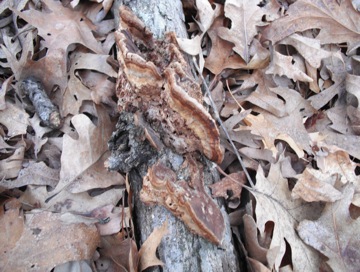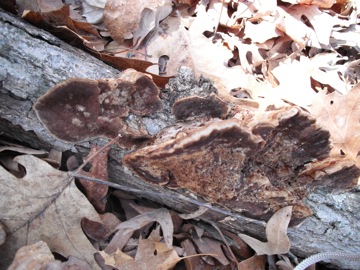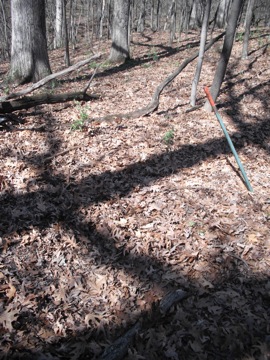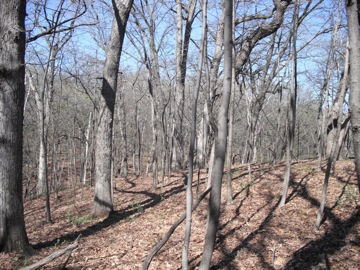Turkey Tail Fungus
Contact
Katharine Ordway Natural History Study Area9550 Inver Grove Trail Inver Grove Heights, MN 55076 651-455-6204 (On Site)
651-696-6230 (On Campus)
andersonm@macalester.edu
Biotic Inventory: Documenting Diversity at the Katharine Ordway Natural History Study Area
Trametes versicolor, the turkey tail mushroom


Taxonomy
Kingdom Fungi
Phylum Basidiomycetes
Class Agaricomycetes
Order Polyporales
Family Polyporaceae
Genus Trametes
Species versicolor
Common name: Turkey tail mushroom5
Diagnostic Characteristics
Indentifying the family that this mushroom belongs to was relatively simple. The specimen lacks any sort of stem, and had a bracket formation – both features which are common in the Polyporaceae Family1. Furthermore, the specimen was found growing on dead wood and possessed a pore surface instead of gills. The combination of these features is unique to the Polyporaceae Family, providing definitive family-level identification1,8. As further proof, the specimen was observed growing on a fallen tree log in Mid April, which confirms that this specimen belongs to the Polyporaceae (polypore) family, as the thicker and tougher bodies of these fungi enable them to overwinter. In general, species from other mushroom families do not begin to appear until June or July7.
However, determining the species and genus of this specimen required closer investigation of more detailed morphological characteristics. The sharply contrasting bands of different colors layered across the cap of the fungi are a characteristic of all Trametes versicolor individuals9. On the other hand, the presence of lighter brown, hard, crust-type growths on the surface of the mushroom body also indicated the possibility that this specimen could be either Inonotus dryadeus (Warted Oak Polypore) or Phellinus robineae (Cracked Cap Polypore). However, Polypores dryadeus is not found in Minnesota2,6, and Polyporus rimosus is only found on living black locust trees3,6, eliminating this possibility, since this specimen is located in Minnesota on a dead log. Therefore, the coloring and appearance of the specimen most closely fit that of Trametes versicolor.
Other members of the Trametes genus also possess gradations in coloring that are similar to those of Trametes versicolor, though not as distinct5. Furthermore, all polypores have, instead of the gills that are commonly found on the underside of mushrooms, miniature pores or holes through which spores can be released (“Polypore” means “many pores”)5. The fact that all polypores share this common feature can make it difficult to distinguish between the different species of any polypore genus. One way to do this is to measure the concentration and size of pores per millimeter. Trametes versicolor is characterized by a pore surface with 3-8 pores per millimeter, which means that it requires very careful observation to see the pores. This feature differentiates Trametes versicolor from other species of Trametes, which posses 1-3 pores per millimeter, making them more readily visible5. The photographs above (specifically the third photo) show the pore surface, but it is difficult to observe the pores. Upon closer examination of the specimen at Ordway, very small pores were visible, which lends further support to the Trametes versicolor classification. A similar differentiating feature is the feel of the mushroom cap, as Trametes versicolor caps are generally either hairy or velvety, while other Trametes species are smooth5. This specimen was velvety on the majority of the surface, except for the light brown colored hard growths.
Despite the burden of evidence pointing towards Trametes versicolor, there are some features of this specimen that do not concur with most descriptions and other photographs of Trametes versicolor. Specifically, Trametes versicolor is described and pictured as having a white or lighter brown pore surface5, while this particular specimen has a dark brown pore surface (though the edge of the fruiting body is cream colored). Finally, the crust-type growth on the upper surface of this mushroom was not pictured or described in any sources. Since it was found in April, it was obvious that this specimen had lived through at least one winter, and possibly more. The pore surface of Trametes versicolor is known to darken with age7, which may provide a partial explanation for these morphological deviations.
Ecology
Trametes versicolor is found attached to dead hardwood or wounded areas on hardwood trees. It is occasionally also found on dead or living conifers. Trametes versicolor is saprophytic, which means that it produces enzymes which decompose dead matter, providing nutrients to the mushroom. Trametes versicolor causes white rot in its host wood. White rot occurs when fungi degrade the brown ligin of plant cells7. This leaves behind the white cellulose, giving white rot its namesake color. Interestingly, this function of Trametes versicolor makes it useful to the paper industry, which uses Trametes versicolor and other white rot producing mushrooms to remove brown ligin, effectively bleaching wood that will be made into paper7.
Trametes versicolor can grow either in a rosette formation or in rows of bracket shaped bodies (also known as conks) that are side-by-side or overlapping5
The cap of Trametes versicolor individuals are between 1-4 inches across, with an outer edge that may be either smooth and uniform or lobed and wavy6. The cap is characterized by defined bands of different colors, which include various shades of cream, gray, yellow, orange and brown9. Some individuals resemble a miniature turkey’s tail9. The inner flesh of the mushroom is 1-2mm thick9. It is white as well as tough and rubbery. The spore surface is also generally white and will create a white spore print7.
This species can be found most frequently from May through December, though the species have the ability to overwinter, so some individuals may be observed year round4.
Life History
Trametes versicolor is a member of the Basidiomycetes Phylum, meaning that it produces spores on its basidia, an organ located inside the tubes which lead to the surface pores. The life cycle begins with the basdiocarp, which is dikaryotic7. This is the fruiting body, which is generally the most visible and largest part of the mushroom. In this case, the basdiocarp is the bracket shaped conk.
The basidia form dikaryotic cells, which have two nuclei. These nuclei fuse together into one, marking entry into the diploid stage of the life cycle. After meiosis these cells are haploid, and four spores are formed, each with one nucleus7.
At this point, spores are released from the body of the mushroom, in this case through the pores. These spores attach to a substrate and, when conditions are favorable, begin to form mycelium. Finally, the mycelium undergoes cytoplasimic fusion, once again forming a dikaryotic entity. This dikaryotic mycelium will produce more fruiting bodies to continue the cycle7.
The fruiting bodies, once grown, often die after one year, but since they can overwinter, have also been known to last several years7.
Distribution
Trametes versicolor is a widespread and very commonly found species. It has a range throughout all of North America, Asia and Europe. It has been identified in almost every state in the US9.
Voucher Information
On April 15th, 2010, this specimen was observed and photographed in a woodland area. It was attached to a log on an elevated plateau near the bank of River Lake at the Katherine Ordway Natural History Study Area in Inver Grove Heights, Minnesota. There was leaf-litter surrounding the specimen, which was mostly composed of oak leaves.


References
1. Brill, S. (2010). Polypores. http://www.wildmanstevebrill.com/Mushrooms.Folder/Polypore.html
2. Emberger, G. (2008). Inonotus dryadeus.
http://www.messiah.edu/Oakes/fungi_on_wood/poroid%20fungi/species%20pages/Inonotus%20dryadeus.htm
3. Emberger, G. (2008). Phellinus robineae.
http://www.messiah.edu/Oakes/fungi_on_wood/poroid%20fungi/species%20pages/Phellinus%20robineae.htm
4. Emberger, G. (2008). Trametes versicolor.
http://www.messiah.edu/Oakes/fungi_on_wood/poroid%20fungi/species%20pages/Trametes%20versicolor.htm
5. Kuo, M. (2005, March). Trametes Versicolor: The Turkey Tail.
http://www.mushroomexpert.com/trametes_versicolor.html
6. Lincoff, G. (1981). The Audubon Society Field Guide to North American mushrooms.
New York: Knopf.
7. Mollen, C., Weber, L., Kollath, R., & Wenborg, B. (2007). Fascinating Fungi of the
North Woods. Duluth, MN: Kollath+Stensaas Pub.
8. Volk, T. (1997). Polypore Primer: An Introduction to the Characters Used to Identify
Poroid Wood Decay Fungi.
http://botit.botany.wisc.edu/toms_fungi/polypore.html
9. Volk, T. Tom Volk’s Fungus of the Month for August 1997.
1997. http://botit.botany.wisc.edu/toms_fungi/aug97.html
Compiled by Elspeth Cavert
Biodiversity & Evolution (BIOL 270) Professr Sarah Boyer. Spring 2010
Specimen collected at Macalester College’s Katharine Ordway Natural History Study Area on April 15, 2010.